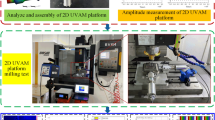Abstract
With the development of the feasibility study on ultrasonic vibration-assisted machining in difficult cutting materials, its surface microstructure and the use performance get more and more attention. In this paper, the 3D roughness and surface residual stress are analyzed based on the experiments of common milling (CM) and ultrasonic vibration-assisted milling (UVAM) TC4 titanium alloy. Besides, the surface friction and wear properties machined by CM and UVAM are compared. The results show that, although arithmetic average deviation (\({s_\mathrm{a}}\)) and root-mean-square deviation (\({s_\mathrm{q}}\)) increase slightly because of the high-frequency vibration, the uniformity and consistency of the surface texture improve obviously. Moreover, the surface residual compressive stress increases with the increasing of the ultrasonic current. Additional, the friction coefficient and wear volume are reduced obviously by the surface microstructure machined by UVAM under oil lubrication. Because there are many continuous pits distribution on the surface, which can not only store the debris but also generate the hydrodynamic effect. However, there is no obvious difference in surface tribological properties machined by CM and UVAM under dry friction, due to the disappearance of hydrodynamic effect.



















Similar content being viewed by others
References
Sun J, Guo YB (2009) A comprehensive experimental study on surface integrity by end milling Ti–6Al–4V. J Mater Process Technol 209(8):4036–4042
Garcabarbosa JA, Arroyoosor JM, Crdobanieto E (2017) Influence of tool inclination on chip formation process and roughness response in ball-end milling of freeform surfaces on Ti–6Al–4V alloy. Mach Sci Technol 21(1):121–135
Zhang ZX, Qu SJ, Feng AH, Shen J, Chen DL (2017) Hot deformation behavior of Ti–6Al–4V alloy: effect of initial microstructure. J Alloys Compd 718:170–181
Devaraj A, Joshi VV, Srivastava A, Manandhar S, Moxson V, Duz A, Lavender C (2016) A low-cost hierarchical nanostructured beta-titanium alloy with high strength. Nat Commun 7:11176
Niu QL, Zheng XH, Ming WW, Chen M (2013) Friction and wear performance of titanium alloys against tungsten carbide under dry sliding and water lubrication. Tribol Trans 56(1):101–108
Yang Y, Zhang C, Wang Y, Dai Y, Luo J (2016) Friction and wear performance of titanium alloy against tungsten carbide lubricated with phosphate ester. Tribol Int 95:27–34
Sui H, Zhang XY, Zhang DY, Jiang XG, Wu RB (2017) Feasibility study of high-speed ultrasonic vibration cutting titanium alloy. J Mater Process Tech 247:111–120
Rey PA, Ledref J, Senatore J, Landon Y (2016) Modelling of cutting forces in orbital drilling of titanium alloy Ti–6Al–4V. Int J Mach Tool Manuf 106:75–88
Wu J, Wen JM, Wang ZY (2016) Study on the predicted model and experiment of drilling forces in drilling Ti6Al4V. J Braz Soc Mech Sci 38(2):465–472
Hsu CY, Huang CK, Wu CY (2007) Milling of MAR-M247 nickel-based super alloy with high temperature and ultrasonic aiding. Int J Adv Manuf Technol 34(9–10):857–866
Dahnel AN, Ascroft H, Barnes S (2016) The effect of varying cutting speeds on tool wear during conventional and ultrasonic assisted drilling (UAD) of carbon fibre composite (CFC) and titanium alloy stacks. Proc CIRP 46:420–423
Li Z, Zhang DY, Jiang XG, Qin W, Geng DX (2016) Study on rotary ultrasonic-assisted drilling of titanium alloys (Ti6Al4V) using 8-facet drill under no cooling condition. Int J Adv Manuf Tech 90:3249–3264
Kumar J (2014) Investigations into the surface quality and micro-hardness in the ultrasonic machining of titanium (ASTM GRADE-1). J Braz Soc Mech Sci 36(4):807–823
Zou X, Cong W, Wu N, Tian Y, Pei ZJ, Wang X (2013) Cutting temperature in rotary ultrasonic machining of titanium: experimental study using novel fabry-perot fibre optic sensors. Int J Manuf Technol Res 8(3):250–261
Dhuria GK, Singh R, Batish A (2017) Application of a hybrid Taguchi-entropy weight-based GRA method to optimize and neural network approach to predict the machining responses in ultrasonic machining of Ti–6Al–4V. J Braz Soc Mech Sci 39(7):1–16
Yu HQ, Gao Y, Wang S (2016) Study on surface roughness of titanium alloy under radial ultrasonic vibration milling. Aeronaut Manuf Technol 4:59–62
Wang M, Li S, Zheng Y (2014) Surface roughness of titanium alloy under ultrasonic vibration milling. Trans Chin Soc Agric Mach 45(6):341–346
Zheng K, Li ZH, Liao WH, Xiao XZ (2017) Friction and wear performance on ultrasonic vibration assisted grinding dental zirconia ceramics against natural tooth. J Braz Soc Mech Sci 39(3):833–843
Zhang JH, Zhao Y, Tian FQ, Zhang S, Guo LS (2015) Kinematics and experimental study on ultrasonic vibration-assisted micro end grinding of silica glass. Int J Adv Manuf Technol 78(9–12):1893–1904
Guo P, Lu Y, Ehmann KF, Cao J (2014) Generation of hierarchical micro-structures for anisotropic wetting by elliptical vibration cutting. CIRP Ann Manuf Technol 63(1):553–556
Acknowledgements
The project was supported by Open Research Fund of Key Laboratory of High Performance Complex Manufacturing, Central South University (Grant No. Kfkt2016-09), National Natural Science Foundation of China (Grant No. 51675284), Aeronautical Science Foundation of China (Grant No. 20171659001).
Author information
Authors and Affiliations
Corresponding author
Additional information
Technical Editor: Márcio Bacci da Silva.
Rights and permissions
About this article
Cite this article
Zheng, K., Liao, W., Dong, Q. et al. Friction and wear on titanium alloy surface machined by ultrasonic vibration-assisted milling. J Braz. Soc. Mech. Sci. Eng. 40, 411 (2018). https://doi.org/10.1007/s40430-018-1336-9
Received:
Accepted:
Published:
DOI: https://doi.org/10.1007/s40430-018-1336-9




